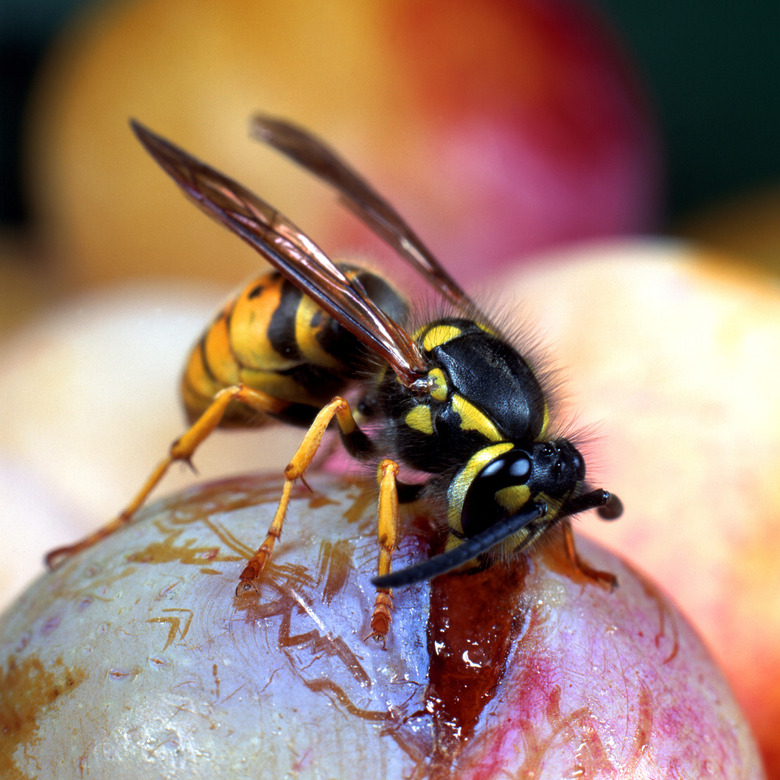How To Exterminate Yellow Jackets & Not Kill Evergreen Bushes
It's midsummer and you notice one or two insects that look like striped bees persistently flying around the table as you're snacking. They are probably western yellowjackets (Vespula pensylvanica). By September, there will be many more, and they can be dangerous for your family. It isn't easy to eliminate them, but there are strategies to keep their numbers down, and they shouldn't have any impact on your evergreen bushes. Even spraying the nest won't affect the bushes, but that's a risky — even foolhardy — proposition that can get you swarmed. You and your children should keep away from the nest.
Step 1
Step 1
Avoid bringing food outside during the late summer and early fall, and cover what food you do bring out. The yellowjacket population grows largest in the late summer, and the insects become increasingly aggressive. They may even sting when you try to swat them. Removing all sources of food is the best way to keep them away.
- It's midsummer and you notice one or two insects that look like striped bees persistently flying around the table as you're snacking.
- It isn't easy to eliminate them, but there are strategies to keep their numbers down, and they shouldn't have any impact on your evergreen bushes.
Step 2
Step 2
Reduce the numbers of yellowjackets around specific areas, such as the porch, by surrounding it with lure traps, available at hardware stores. They contain a chemical, heptyl butyrate, that attracts western yellowjackets. If you suspect that your infestation includes other species, such as the German yellowjacket (Vespula germanica), put some meat in each trap to attract them.
Step 3
Step 3
Place the traps around the perimeter of your yard to protect your entire property. Check each trap frequently to make sure insects are still attracted, and change the meat frequently. Yellowjackets aren't attracted to rotting meat.
Step 4
Step 4
Make your own lure traps with plastic soft drink bottles. Leave a little of the soft drink in the bottom of the bottle and add a dab of dish soap. The wasps will fly down to drink, get caught in the soapy water and drown. Replace the bottles with fresh ones every few days.
- Reduce the numbers of yellowjackets around specific areas, such as the porch, by surrounding it with lure traps, available at hardware stores.
Step 5
Step 5
Fill a large bucket with soapy water and cover it with chicken wire to keep pets away. Suspend a piece of meat from the wire so that it hangs about 2 inches above the water. Yellowjackets will fly in, feed on the meat, fall into the water and drown.
Step 6
Step 6
Mix dish or laundry detergent with water to make a soapy solution and pour it into the nest to eliminate the nest early in the season. Wear protective clothing, shoes and a face veil when doing this. This is safe to do until about mid June. After this time, the increasing number of insects makes extermination of the nest a job for a professional.
- Fill a large bucket with soapy water and cover it with chicken wire to keep pets away.
Tip
If you become aware of a yellowjacket nest after mid June, the best way to deal with it is to leave it alone and stay away from it. The insects die in the winter and won't return to that nest nest year.
Warning
Cordon off the area around a yellowjacket nest so that your children stay at least 10 feet away from it and warn them of the danger. The wasps are aggressively protective of the nest and will swarm anyone who comes near, even at night.
Warning
The effects of a yellowjacket sting range from short-term intense discomfort to swelling, itching and life-threatening allergic reactions. If your child has a strong reaction, seek medical attention immediately.
Things Needed
- Lure traps
- Meat
- Soft drink bottles
- Dish or laundry soap
- Bucket
- Chicken wire
- Protective clothing and shoes
- Face veil
